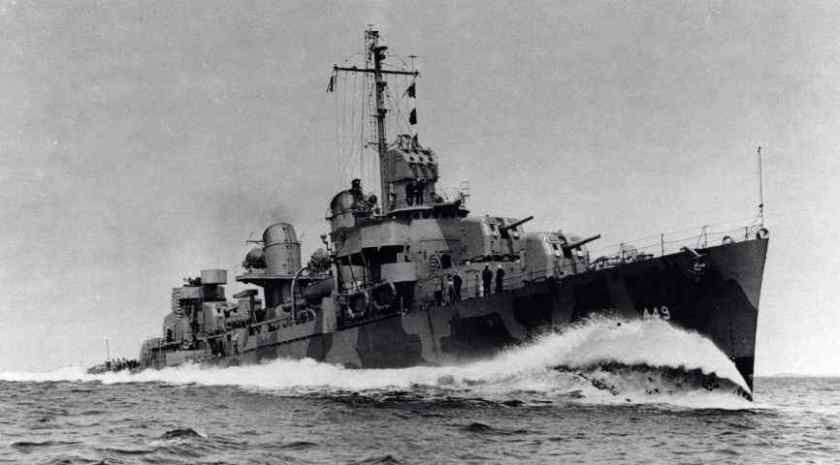As many of you already know, I am a lover of history. Maritime history is especially one of my favorite sub-fields of history, and I love to see historic ships or reproductions of historic ships at any opportunity. I am lucky enough to live in a state (and a region) that has many.
So I went to the old Navy Yard in Charlestown on Saturday, since my back was feeling a bit better and I was feeling up to doing some walking around. And I am so very glad I did, because for the first time ever I got to take a tour of the inside of the USS Cassin Young, one of the museum ships kept there by the National Park Service.
Before I begin, I have to talk a little about about this specific kind of ship, a Fletcher-class destroyer from World War Two (although this particular one was modernized in the 1950s to some extent). Big ships like aircraft carriers, battleships and cruisers are exciting, but the two kinds of ships that have fascinated me the most are submarines and destroyers. I am not really sure I can say why. Perhaps because the crews were much smaller and thus more likely to know everyone. Perhaps because there were so many, that they represented a more common experience for many sailors. Perhaps because those two types of ships epitomized so much of the naval conflict of the Second World War. Or perhaps because I had a grandfather on submarines and a great-uncle on destroyers. Certainly I remember growing up building models of both. And I particularly loved my super-detailed model of a Fletcher-class destroyer.
I have heard the Fletchers (and destroyers generally) described as “greyhounds of the sea”, the “cavalry of the Navy”, and “the real Navy”. They were the first class of destroyers built without any of the earlier Naval treaty restrictions on design, and so the designers made a mighty effort to correct all of the problems that had caused complaints about previous classes of destroyers, particularly problems with being top-heavy, which caused numerous problems for those older classes. The Fletchers were large, fast, and heavily armed. And they were quite stable, having the ability to have a lot of additional antiaircraft armament added, especially later in the war when kamikazes became such a problem for the Navy. And to put it in perspective, the Fletchers were so fast that they are actually faster than modern destroyers. A modern destroyer such as an Arleigh Burke class can probably get up to 33 knots or so, the equivalent of 38 miles per hour, although admittedly I don’t know whether or not they have a classified figure that is higher. But at any rate the Fletchers could get up to 36 or even 38 knots, or 41 to 44 miles an hour. Man, I would love to see that. When a ship like that was going at full speed (called flank speed in Navy terms) the ship would kick up quite a lot of water at her bow. That was called “having a bone in her teeth”.

Pretty impressive for something so big. At least I think so.
Anyway, one of the really revolutionary things about the Fletcher class was its new fire control computer, the Mark 1A, built by the Ford company. This gigantic analog computer required a lot of manual input to make it work properly, but wow was it an improvement over the old way of doing things. I actually got to see the Mark1A installed in the Cassin Young but I got so excited that I literally forgot to stop and take a photo. Duh. So here’s a diagram from Wikipedia to give you an idea.

This magnificent contraption allowed the gunnery officer, way up in the director on top of the bridge (you can see it in the photo of the Nicholas, it’s that weird boxy thing that looks like a turret with no guns) to simultaneously direct all five of the destroyer’s 5 inch guns. And the computer would compensate for all sorts of stuff like wind, temperature, type of ammunition, and the motion of the ship. So from a distance you could watch the ship pitch up and down while the gun barrels remained (seemingly) perfectly still, pointed at the target selected by the gunnery director. It is exactly the way the main gun on a modern M1 tank works as well. And it allowed the Fletchers to hit their targets with remarkable accuracy.
Here’s the front two 5 inch guns on the Cassin Young.

This is looking up toward the bridge. And this next photo is sort of the opposite, looking down from the bridge past these two mounts.

I love that you can get a good view into the old No. 1 Dry Dock from the bridge. They are apparently in the midst of a major restoration project there. You can also see a lot of the Yard from the bridge, and the Bunker Hill monument in the background too.
Anyway, looks like this post is getting kind of long, so I will have to save the rest for more posts in the near future. Much more to come soon!
-Geoff
